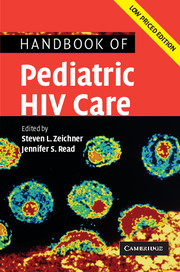Book contents
- Frontmatter
- Contents
- List of contributors
- List of abbreviations
- Foreword
- Preface
- Part I Scientific basis of pediatric HIV care
- Part II General issues in the care of pediatric HIV patients
- Part III Antiretroviral therapy
- Part IV Clinical manifestations of HIV infection in children
- Part V Infectious problems in pediatric HIV disease
- 30 Serious infections caused by typical bacteria
- 31 Tuberculosis
- 32 Disseminated Mycobacterium avium complex infection
- 33 Fungal infections
- 34 Herpesvirus infections
- 35 Pneumocystis jiroveci pneumonia
- Part VI Medical, social, and legal issues
- Appendix 1 Formulary of antiretroviral agents
- Appendix 2 National Institutes of Health sponsored clinical trials for pediatric HIV disease
- Appendix 3 Selected HIV-related internet resources
- Appendix 4 Selected legal resources for HIV-infected children
- Index
- References
33 - Fungal infections
Published online by Cambridge University Press: 23 December 2009
- Frontmatter
- Contents
- List of contributors
- List of abbreviations
- Foreword
- Preface
- Part I Scientific basis of pediatric HIV care
- Part II General issues in the care of pediatric HIV patients
- Part III Antiretroviral therapy
- Part IV Clinical manifestations of HIV infection in children
- Part V Infectious problems in pediatric HIV disease
- 30 Serious infections caused by typical bacteria
- 31 Tuberculosis
- 32 Disseminated Mycobacterium avium complex infection
- 33 Fungal infections
- 34 Herpesvirus infections
- 35 Pneumocystis jiroveci pneumonia
- Part VI Medical, social, and legal issues
- Appendix 1 Formulary of antiretroviral agents
- Appendix 2 National Institutes of Health sponsored clinical trials for pediatric HIV disease
- Appendix 3 Selected HIV-related internet resources
- Appendix 4 Selected legal resources for HIV-infected children
- Index
- References
Summary
Introduction
Fungal infections represent an important cause of morbidity and mortality in HIV-infected children [1] (Table 33.1). Most children with low CD4+ lymphocyte counts develop mucosal candidiasis that increases in severity with worsening immunosuppression [2]. Invasive fungal infections due to primary pathogens such as Cryptococcus neoformans, Coccidioides immitis, Histoplasma capsulatum, Penicillium marneffei, and others occur less frequently in pediatric than in adult patients with the acquired immunodeficiency syndrome (AIDS), probably because children are less likely to be exposed to these agents. More recently, invasive pulmonary aspergillosis has emerged as an HIV-associated complication.
Fungal infections may present with atypical clinical manifestations making their recognition a challenge. When fungal cultures or serologic or antigenic markers are negative, biopsies of affected sites can help in making a diagnosis [3].
Recently, the therapeutic options for invasive fungal infections have broadened with the introduction of the triazole compounds fluconazole and itraconazole, the lipid formulations of amphotericin B, the allilamine terbinafine, and, the echinocandin caspofungin [4–7]. These antifungals have different pharmacological properties and clinically important drug interactions that must be considered (Tables 33.2 and 33.3) [7–9]. Despite these advances, there are still a limited number of effective and safe antifungal agents (Table 33.4).
Cutaneous infections
Cutaneous candidiasis
Cutaneous candidiasis may develop as diaper dermatitis or as a more generalized eruption [10].
- Type
- Chapter
- Information
- Handbook of Pediatric HIV Care , pp. 695 - 720Publisher: Cambridge University PressPrint publication year: 2006



